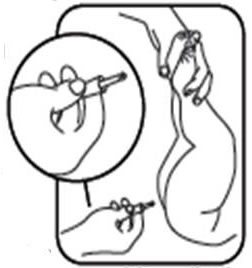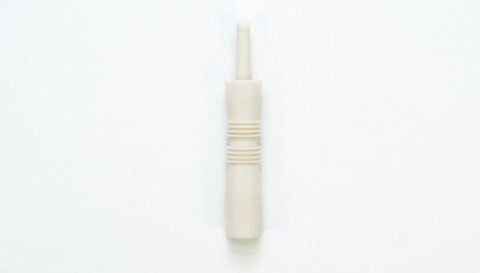We tend to cover some very serious topics here on Science-Based Medicine. In fact, most of our posts are downright depressing. This will hopefully not be one of them.
In just the past few weeks we have written about the public health menace of anti-vaccine pseudoscience, autistic children being subjected to dangerous bleach enemas, and chiropractic-induced stroke in children. Unsurprisingly, there is typically no shortage of rage and heartache on the pages of this blog. But not today. Today will be a reprieve from the misery.
I’ll be discussing two products that were recently brought to my attention by colleagues. The last product I skeptically evaluated was the Buzzy, a device designed to reduce procedural pain in kids that is little more than a clever distraction technique. That product, however, was considerably more complex in concept and design than the ones I’ve chosen for this post. But the NoseFrida and the Windi are marketed to parents using equally dubious claims of efficacy, and use of one of them has an unfavorable risk-benefit analysis in my opinion. At least they’re funny…kind of.
The NoseFrida and the Windi come from the Miami-based FridaBaby LLC. The company website provides a succinct mission statement:
FridaBaby specializes in baby products you actually need! Our products are for the important stuff, you know, like breathing. Instead of using harsh chemicals to relieve your baby of discomfort, we opt for more natural solutions. Our focus on pragmatic and “gross” products (their words, not ours, nothing grosses us out!) that really work has garnered us a cult like following of ENTs, pediatric GIs nurses, doulas, midwives, lactation consultants, bloggers, and parents.
Okay, they help promote a needless anxiety over chemicals in baby products, and yes, that statement contains a straw man implication that all other options require the use of “harsh chemicals”, but they seem like decent enough folks. Who doesn’t like breathing? I do it daily and recommend it to all my patients.
They are also likely exaggerating a bit when referring to their “cult-like following.” They sell products, some people buy them, and a certain percentage of those purchased are subsequently used. There aren’t FridaBaby fan conventions. People don’t dress up as their favorite product for midnight screenings of FridaBaby commercials. Users don’t identify themselves as part of the FridaBaby community and get into arguments with fans of competing product lines over irrelevant minutiae.
FridaBaby’s biggest claim to fame so far is their NoseFrida. It’s a nasal aspirator that requires the parent to personally suck snot out of their baby’s nose using their mouth and a plastic tube. I understand the appeal, if not the ability to stifle a vomit reflex. Parents of children admitted to the hospital often ask if they can have a hospital-grade nasal suction device at home that is similar to what we use for babies with severe nasal congestion and subsequent difficulty feeding. Babies primarily breathe through their nose for the first few months of life and sometimes do prefer to breathe rather than eat. Hospital-grade devices don’t improve outcomes in these babies but they give us something to do instead of just “masterful inactivity.”
There are a variety of battery-powered electric nasal aspirators on the market but the NoseFrida is equally effective, cheaper, and appeals to a certain demographic because it’s Swedish and doesn’t produce a toxic electromagnetic field. It also works as well as any other non-electric home nasal suction device, like the classic bulb syringe, which is to say that it gives the parents something to do that might elicit a bit of placebo. The filter keeps snot from reaching the parent’s mouth, it’s perfectly safe, and it’s easy to clean.
None of these devices really have a clinically-meaningful impact on the ability of a baby to breathe through their nose, but many parents swear by them. All require the use of nasal saline, which is what actually helps. The mixture of saline and snot can either drain into the throat or be sucked out in quantities that inspire positive placebo-driven parental testimonials. Either way, at most there may be a brief and minor increase in air flow through the nose. Of course all the saline and suction in the world won’t reduce swollen nasal passages caused by viral-mediated inflammation, and aggressive suctioning might actually make things worse. But if using a NoseFrida or renting a professional grade industrial NoseVac from Home Depot keeps a parent from giving their baby an ineffective and unsafe OTC cold medications, then I’m on board.
The Windi is definitely a horse of a different color as described on the website (I’ve emboldened the more concerning statements):
Overview
A natural solution for colic, constipation, and other gas-related problems, The Windi works instantly and does not require ingestion of any drops or medication. The Windi is a single-use catheter that helps babies get rid of excess gas. Designed to be safe and effective, The Windi cannot harm your baby if used as instructed. Most pediatric professionals are familiar with the method of using a rectal thermometer to relieve gas, colic, and constipation. The Windi is designed specifically for this purpose. The soft, pliable, hollow tube features a rounded tip that is long enough to reach past the muscle that prevents the release of the gas, and also has a stopper to prevent an insertion too far.
Instructions
- Gently massage the child’s stomach with your hand in a downward motion towards the rectum. Massage one side of the belly at a time. Repeat three times on each side.
- Lift the child’s legs towards the head and carefully insert the catheter into the rectum (as if you were using a thermometer). Always use baby oil on the tip of the catheter to ease insertion. You will hear a “whistling” sound when the gas comes out and notice immediate relief in the child. Remove The Windi and dispose of it.
- It should only take a few seconds after inserting The Windi to achieve the desired effect. If it does not work immediately, repeat the procedure with massage and try again. Sometimes you need to repeat several times and in this case, the same catheter can be reused.
Warning
- Never leave The Windi in the rectum of the child!
- Always discard The Windi after you have finished the treatment to prevent infection. Reuse of the same Windi may pose a risk of infection.
- Never use The Windi treatment more than three times per 24 hour period.
- Always use baby oil on the tip of The Windi.
- The Windi is not a toy – keep all parts out of reach of children
There is a lot to unpack here, like how I’m not entirely sure what’s so natural about shoving a molded plastic device into a child’s rectum. The provided product information is full of half-truths and blatant misrepresentations of reality. It’s also a bit confusing at times, such as when it states that symptom relief may require sessions of several repeat insertions but that exceeding three daily “treatments” is strongly discouraged. Is it three total insertions or three sessions during which a child can undergo the procedure several times?
I’ve discussed colic on SBM in the past, going into great detail in a prior post. But here is a brief synopsis. Colic is the name we have given to the behavior of babies, typically between the ages of three weeks and four months, that seem to cry more than other babies based on a fairly arbitrary cutoff. It’s a diagnosis of exclusion, meaning actual illness or injury needs to be ruled out first, and the best science we have on the subject points towards colic being primarily a psychosocial construct in most children.
As with most behaviors, there is a bell curve to crying and some babies tend to fuss more than others. But what is likely the most important factor in a child receiving a diagnosis of colic is the caregiver’s perception of that crying. Parental perception can be significantly impacted by many factors, such as stress and lack of sleep, that increase their sensitivity to crying. These factors can also negatively impact interactions between the parent and child, increase crying, and alter the perception of it in a vicious cycle.
Some babies have medical conditions that mimic colic, but they almost always have other findings or historical clues that differentiate them. Milk protein allergy is the one that has the best evidence in support of empiric treatment, typically with a specialized formula, in babies that fail to respond to soothing techniques and attempts to manage parental perception problems. But colic is not caused by reflux or constipation, and it is not caused by gas.
Babies produce gas as their feeds are digested just like older children and adults. All babies are gassy. All babies have periods of fussiness. They are rarely related, and when they are it is more plausibly because of gaseous distention of the stomach which is usually relieved by burping. But even that example is based more on lore than evidence.
Adults will sometimes describe a bloated feeling caused by gas, but pain related to gas is an infrequent medical complaint. The overwhelming majority of humans old enough to express their feelings experience varying amounts of gas every day without any problem, yet we assume that virtually all babies experience frequent episodes of discomfort or pain to the point of excessive crying because of it. Gas in the rectum in particular doesn’t hurt and removing gas from the rectum with a device only seems to work via manipulation of parental perception of their baby’s demeanor.
In addition to simple cultural inertia, there is a condition in young infants, really a description of normal development, that probably plays a role in widespread belief in the power of baby gas and the need to intervene with products like the Windi. Infant dyschezia is the name for when babies strain, grunt, and cry for at least ten minutes several times a day prior to passing gas or stool. It is affects most babies at some point in the first several weeks of life and is the result of an inability to coordinate relaxation of the pelvic floor musculature and intra-abdominal pressure (valsalva).
Infant dyschezia is nearly always misinterpreted as pain related to gas or constipation. It is neither. Crying and straining is merely the baby’s reflexive attempt to valsalva harder against closed anal sphincters. It is not caused by pain or discomfort. When these episodes result in stool, it is normal soft baby poop.
Unfortunately it is common for parents to experience anxiety related to infant dyschezia and to seek out medical care for gas and/or constipation. Many parents have been told, by well-meaning friends and family, and even the occasional medical professional, that using a rectal thermometer (or the Windi) to open up the anus is necessary to relieve their baby’s suffering. And this will sometimes result in a rush of gas or poop. The concerning baby behavior will then stop, which reinforces the parental desire for more intervention.
The problem with this is that infant dyschezia is part of normal development. They will eventually reach the milestone of being able to coordinate defecation and passing gas easily. Frequent rectal stimulation will actually delay this process and even potentially result in a baby that is dependent on rectal insertion in order to stool normally. So despite what is cleverly implied on the Windi website, most pediatric professionals specifically recommend against this method.
As far as use of the Windi for constipation goes, this is also inappropriate. First off, young infants who have yet to begin solid foods are rarely constipated. In the uncommon case of a young infant with acute constipation, or with the much more common occurrence of acute constipation in older kids, the safest and most effective treatment is from above with something to soften the stool. In children with chronic constipation who have developed an impaction, it is sometimes necessary to treat from below in order to remove old hard stool while lifestyle modification and use of oral stool softeners are optimized. A product like the Windi will not suffice as these children need a glycerin suppository or enema.
Conclusion: Not dangerous, also not useful
New parents are bombarded with recommendations for products to help make caring for their baby more tolerable, and they range from the silly to the dangerous. The NoseFrida and the Windi are certainly not dangerous, but they are likely a waste of money. Luckily they are fairly inexpensive.
In the grand scheme of things, it is unlikely that these two products will cause the downfall of our modern civilization. And I’m certainly not comparing promotion or use of these products to the bogus remedies and risky pseudoscience typically found in the posts on SBM. I doubt we will see any NoseFrida or Windi-related deaths.
But the Windi will likely be used by parents to treat a harmless and normal aspect of development and is not risk free. Frequent use may actually delay development of the ability to pass stool and gas easily in young infants. Removal of gas from the rectum will not treat colic because gas in the rectum is not the cause of colic or fussing in infants in general.



